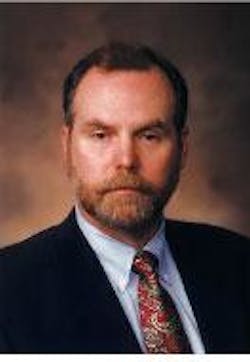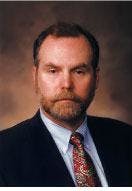The Internet: a 'non-geodesic' network
Telecommunications networks today are thought to be "geodesic," a metaphor popularized by Peter Huber in his 1987 and 1991 reports, each named "The Geodesic Network" and each a powerful tool in the battle to deregulate telephone companies. He applied the term only to local telephone networks and wrote, "[G]eodesy, while not a mystical ultimate stopping point, is still the best metaphor we have to describe the direction in which the network is evolving." Although he explicitly refrained from applying it to long-distance networks, the metaphor was so popular that its coverage expanded to telecommunications networks in general.
Huber borrowed the term from Buckminster Fuller, an architect who wrote The Geodesic Dome over 30 years ago. A layman's geodesic network is typically illustrated as a mosaic of triangles connected to each other at their end points, where each side is a transmission path and each end point is a network node linked to another network and its nodes.
In a geodesic mosaic, any two points can communicate with each other over hundreds of different routes, where each route is used just as much as any other--unlike a backbone network, where all traffic passes through only a few routes. Geodesic communications networks are supposed to be more efficient and more stable than backbone networks regardless of the material used in the network. Thus, even if all telecommunications networks were composed of nothing but fiber-optic paths, a geodesic fiber network would be better than a backbone fiber network.
The geodesic design has regulatory implications, too. If there are hundreds of alternative paths between communications points, then there is no need to fear monopoly control. Thus, there is little justification for regulating a geodesic network.
The deregulation trend of the 1990s could not have happened without Huber's metaphor being accepted as accurately describing telecommunications networks. In 1991, he argued that since local networks were geodesic, "the local exchange should be and soon will be competitive." There is still plenty of disagreement about whether local networks are competitive and geodesic. However, a recent empirical study suggests the world's most popular and fastest-growing network, the Internet, is not geodesic at all, but a loosely cooperating group dominated by a handful of backbones straining under a heavy load. Nature's Web Matters recently published a study by the Cooperative Association for Internet Data Analysis (CAIDA) that found the Internet to be very dependent on certain backbones to transmit data and that alternative paths were lightly used. CAIDA, with headquarters at the University of California's San Diego Supercomputer Center, traced the round-trip routes of data packets it sent from San Diego to nearly 21,000 Internet destinations around the world.
CAIDA discovered the packets traveled over 20 different interconnected backbones, but 70% of the time, the packets were routed through four backbones: CerfNet/AT&T accounted for 34%, Cable & Wireless (recently purchasing InternetMCI's backbone) 14%, Sprint 11%, and UUNET (part of MCI WorldCom) 11%. This wide disparity in traffic distribution among the backbones is clear proof that the Internet is not geodesic, and when the top backbones fail, it is subject to substantial disruption because packet traffic is not even close to being equally distributed across equivalent paths.
CAIDA's study also found severe problems with certain switch points, called routers, that receive and forward the packets through the Internet. Packets passing through routers that "cache," a process where certain incoming packets are stored and then resent in an order occasionally different than they were received, took two to 10 times as long to complete a round trip in comparison to routers that did not cache. From this, CAIDA inferred, "[I]nstead of consistent performance, a significant fraction of the data sent over the Internet takes a very long time to reach its destination, if it ever arrives at all."
Caching is not needed in a truly geodesic network but goes hand-in-hand with backbone networks. In stark contrast with Huber's thesis that a competitive telecommunications industry would be a geodesic network, CAIDA says the Internet's transition to "competitive industry...left no framework for...communications needed for engineering or debugging problems....Nor did competitive providers...consider it to be in their best interests to build such a framework." CAIDA's findings do not support the thesis that data transport through the Internet is a competitive market.
This conclusion shocks people and contradicts the Internet's image as a golden goose benefiting everyone. But Huber predicted this situation in his 1991 report: "If there is going to be a monopoly, it will be in the long-distance market....[It] bears watching...because it is so critical to so many other markets...[and] an essential component of every successful online service." It's true--the Internet would be nothing if it did not embody long-distance markets. The Federal Communications Commission (FCC) recently affirmed this view in February when it ruled that a telephone call to the Internet is an interstate service falling within the agency's jurisdiction, even if the service provider is next door. As one observer explained, the FCC's decision was technically correct because the Internet "is everywhere at once."
The pesky, ubiquitous Internet is a troublemaker for the FCC, and the commission is finally receiving professional help from its very own technological advisory council, replete with the best and brightest who will shepherd the agency through a "period of exceptionally rapid technological change," according to FCC chairman William Kennard. The agency's chief of engineering and technology, Dale Hatfield, added, "We are eager for the council to analyze the difficult technical issues facing the commission in such areas as spectrum management, convergence, and the Internet. Sound technical advice is essential to our developing the best policies to serve the public."
The council includes two Internet experts whose companies have a big stake in the Internet's architecture: Vincent Cerf, MCI WorldCom's senior vice president for Internet architecture and technology, and David Nagel, president of AT&T Labs and chief technical officer for AT&T. These advisers could help the FCC develop sound Internet policy by keeping the agency informed of the progress in the Next Generation Internet effort, now being funded by the Defense Advanced Research Projects Agency (DARPA).
An important player in this effort is Alan Huang, who recently received funding from DARPA to carry out the "scalable switching" concepts he patented last November. The invention aims at eliminating congestion for traffic going into and leaving a network node, rationally distributing traffic loads across different paths, and thereby balancing the traffic far better than it is today. Better balancing will improve the Internet's ability to work properly in the event certain paths fail.
Huang makes a long story short by defining a scalable switch according to certain mathematical rules. For N inputs, there are N3 routers arranged in N2 columns and N rows with N outputs. In a scheme with 3 inputs, there are 27 routers arranged in 9 columns with 3 rows and 3 outputs. Huang uses number theory to define connections from row 1 to row 2 as: Row 1 routers (1, 4, 7) each map to row 2 routers (1, 3, 5); row 1 routers (2, 5, 8) each map to row 2 routers (2, 7, 9); and row 1 routers (3, 6, 9) each map to row 2 routers (4, 6, 8). That pattern is repeated in row 2's mapping to row 3. Stability and flexibility is enhanced by adding a fourth router row, mapped from row 3 just as row 3 is mapped from row 2. This pattern is repeated for any number of inputs, where the mapping from row to row changes accordingly. With this configuration Huang's patent claims that "each router port has access to its own buffers and to a shared pool of buffers," key concepts in dealing with congestion.
If the Internet backbones incorporate Huang's invention, it will reduce and perhaps eliminate the misapportioned traffic loads that CAIDA found, eliminate redundant hardware in switches, making caching useful for a purpose other than delaying packets to relieve congestion and make the Internet more akin to a true geodesic network. Of course, a commercial issue immediately rises: Do the dominant carriers want to see Internet traffic more rationally balanced, if their revenues depend on the imbalance? The FCC's new advisers need to make sure that the technical progress embodied in Huang's patent is not suppressed or delayed by commercial enterprises happy with the current state of affairs.Stephen N. Brown writes on public policy in telecommunications. He can be contacted by e-mail at [email protected] or telephone: (615) 399-1239.

